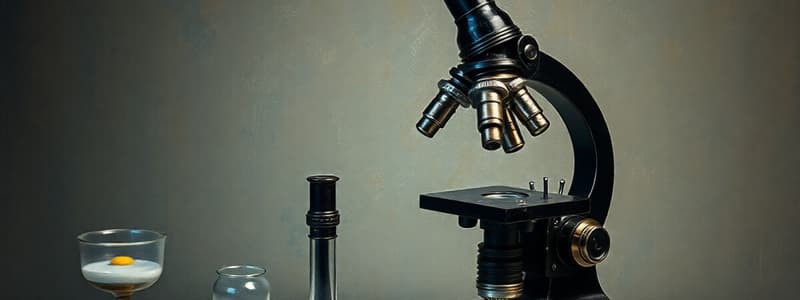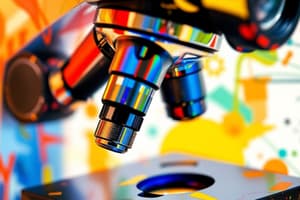Podcast
Questions and Answers
What is the correct method for holding the microscope?
What is the correct method for holding the microscope?
- With one hand on the base and one on the eyepiece.
- With two hands, one under the base and one on the arm. (correct)
- Using only one hand under the base.
- With both hands on the eyepiece.
Which lens should be used for initial observation of a slide?
Which lens should be used for initial observation of a slide?
- High-power objective lens (40x).
- Low-power objective lens (4x). (correct)
- Any available objective lens.
- Medium-power objective lens (10x).
What should be done with the microscope lenses for maintenance?
What should be done with the microscope lenses for maintenance?
- Use clothing to remove smudges.
- Wipe with a paper towel.
- Use dust to clean them.
- Clean with lens cleaner and lens paper. (correct)
Which adjustment knob should be used when observing with the high-power objective lens?
Which adjustment knob should be used when observing with the high-power objective lens?
What should be done before putting away the microscope?
What should be done before putting away the microscope?
How should the microscope be stored?
How should the microscope be stored?
What is the consequence of dropping a coverslip onto the slide?
What is the consequence of dropping a coverslip onto the slide?
Which step should be taken when focusing a specimen under low power?
Which step should be taken when focusing a specimen under low power?
What is the primary function of the eyepiece in a microscope?
What is the primary function of the eyepiece in a microscope?
Which component of the microscope is used to control the amount of light entering the condenser?
Which component of the microscope is used to control the amount of light entering the condenser?
What is the purpose of the coarse adjustment knob on a microscope?
What is the purpose of the coarse adjustment knob on a microscope?
How does the condenser function in a compound light microscope?
How does the condenser function in a compound light microscope?
Which part of the microscope is used for making precise, small adjustments during imaging?
Which part of the microscope is used for making precise, small adjustments during imaging?
What is the main use of the objective lenses in a microscope?
What is the main use of the objective lenses in a microscope?
What role does the arm serve in the structure of a microscope?
What role does the arm serve in the structure of a microscope?
Which part allows for the rotation of different objective lenses in a microscope?
Which part allows for the rotation of different objective lenses in a microscope?
What happens to the image of the specimen when viewed under the microscope?
What happens to the image of the specimen when viewed under the microscope?
Which part of the microscope is adjusted to change the amount of light passing through the specimen?
Which part of the microscope is adjusted to change the amount of light passing through the specimen?
When using a low power objective (LPO), how much of the letter typically occupies the field of view?
When using a low power objective (LPO), how much of the letter typically occupies the field of view?
What is the primary purpose of the methylene blue stain used during a wet mount preparation?
What is the primary purpose of the methylene blue stain used during a wet mount preparation?
What is the effect of using the fine-focus knob after switching the objective lens?
What is the effect of using the fine-focus knob after switching the objective lens?
Which lenses are present in a compound microscope?
Which lenses are present in a compound microscope?
What occurs to light as it passes through a convex lens in a microscope?
What occurs to light as it passes through a convex lens in a microscope?
What is the orientation of an arrow-shaped object viewed through a microscope?
What is the orientation of an arrow-shaped object viewed through a microscope?
What is the total magnification when using a 20x objective lens with a 10x ocular lens?
What is the total magnification when using a 20x objective lens with a 10x ocular lens?
What occurs to the working distance when switching from a low-power objective lens to a higher-power lens?
What occurs to the working distance when switching from a low-power objective lens to a higher-power lens?
What is the primary function of the iris diaphragm on a microscope?
What is the primary function of the iris diaphragm on a microscope?
What should be done when using the oil immersion lens during microscopy?
What should be done when using the oil immersion lens during microscopy?
What is the proper way to carry a microscope?
What is the proper way to carry a microscope?
What is the name of the glass plate placed over a specimen during microscopy?
What is the name of the glass plate placed over a specimen during microscopy?
What is a suitable reason to use the low-power objective lens?
What is a suitable reason to use the low-power objective lens?
What might happen if the oil immersion lens is moved without first removing the slide?
What might happen if the oil immersion lens is moved without first removing the slide?
Flashcards are hidden until you start studying
Study Notes
Microscope Parts and Functions
- Eyepieces/Ocular Lens: Viewer looks through this lens, located opposite the light source
- Base: Flat structure that supports the microscope
- Stage: Holds and navigates the sample
- Arm: Connects the base to the nosepiece and eyepiece, used for carrying the microscope
- Nosepiece: Holds the objective lenses, can be rotated to select different lenses
- Objective Lenses: Primary magnifying lenses
- Condenser: Controls the light that falls on the sample
- Light Source: Illuminates the sample with transmitted light
- Diaphragm: Controls the amount of light entering the condenser
- Coarse Adjustment Knob: Makes larger movements, used for bringing the objective down to the stage or vice versa
- Fine Adjustment Knob: Makes smaller movements, used for final focusing and small adjustments during imaging
Microscope Care
- Carry the microscope securely with two hands: one under the base, one on the arm
- Keep the microscope upright
- Clean lenses with lens cleaner and lens paper, do not use paper towels or clothing
- Only use the fine-focus knob when using the high-power objective lens
- Remove slides before putting the microscope away
- Store with the low-power objective in place
- Lower the stage before putting the microscope away
Microscopy Procedure
- A. Using the Microscope:
- Familiarize yourself with the parts of the microscope
- Turn on the microscope with the ocular lens facing you
- Start with the low-power objective (4x)
- Raise the condenser lens to its highest level
- Cut out letters from newsprint and place them on a slide with a drop of water
- Cover with a coverslip, avoiding air bubbles
- Place the slide on the stage, centered and secured with the stage clip
- Use the coarse adjustment knob to bring the specimen into focus
- Adjust the light using the base, iris diaphragm lever, or condenser lens
- Draw the letter under low power
- Switch to higher powers (10x, 40x) and adjust focus using the fine-focus knob
- Observe the effect of magnification on the size of the image and the field of view
- B. Preparation of a Wet Mount:
- Scrape the inside of your cheek with a toothpick
- Smear the cheek material on a clean microscope slide
- Add a drop of methylene blue stain
- Cover with a coverslip and examine under the microscope
- Draw a single cheek cell
- C. Observation of a Prepared Tissue Slide:
- Examine a prepared slide under low power
- Scan the area and select areas for closer observation
- Switch to higher power and adjust focus using the fine-focus knob
- Draw what you see
- D. Oil Immersion Lens:
- Once you have examined the specimen under high power, center the area of interest in the field of view
- Add a drop of immersion oil on top of the coverslip
- Carefully move the oil immersion lens into place
- Use only the fine-focus knob to avoid damaging the slide
- After examining, swing the lens away and remove the slide, wiping away the oil with lens paper
Compound Microscope
- Uses two convex lenses: ocular lens and objective lens
- Light passing through a convex lens bends and converges at a point, creating an inverted image
- The objective lens creates an inverted image of the specimen, which is then further magnified by the eyepiece, remaining inverted
Post-Discussion Questions
- 1. Total magnification is calculated by multiplying the ocular lens magnification by the objective lens magnification.
- 7x objective lens = 70x total magnification
- 15x objective lens = 150x total magnification
- 20x objective lens = 200x total magnification
- 2. The glass plate placed on top of a specimen is called a coverslip.
- 3. The iris diaphragm controls the amount of light entering the condenser.
- 4. When switching from a low-power objective to a higher-power objective, the working distance between the lens and the coverslip decreases.
- 5. The low-power objective should be used when:
- Viewing a new slide
- When the specimen is lost in the field of view under a high-power objective
- 6. The proper way to carry a microscope is to securely hold it with two hands: one on the arm and the other under the base.
Studying That Suits You
Use AI to generate personalized quizzes and flashcards to suit your learning preferences.




